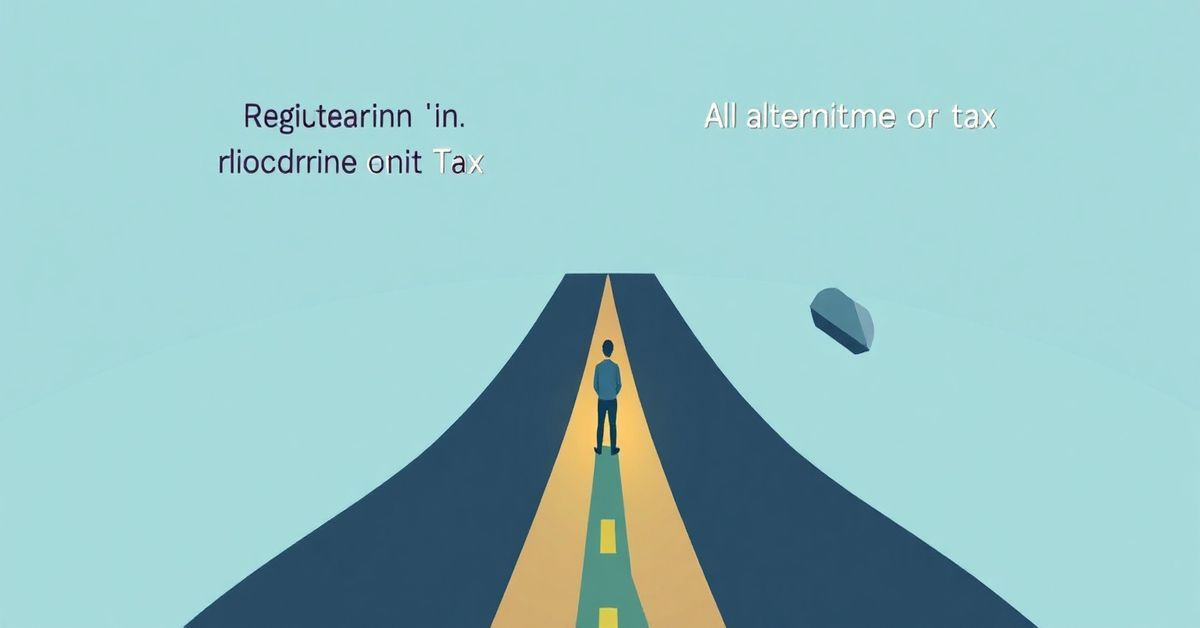Why Do We Even Have the Alternative Minimum Tax (AMT)?
Imagine a tax system where some very wealthy individuals could use a bunch of loopholes to significantly reduce or even eliminate their taxes. That wasn’t the intention, right? The Alternative Minimum Tax (AMT) was created in 1969 for exactly this reason. Back then, a few very wealthy people were finding legal ways to pay little to no income tax. The government decided that wasn’t fair and put the AMT in place to ensure that everyone pays their share. The tax system has changed so much, that the AMT actually affects middle class individuals now.
How Does the AMT Actually Work?
The AMT is like a parallel universe for your taxes. You’re going to have to calculate your taxes twice. Here’s how it roughly goes:
- Regular Income Tax Calculation: You figure out your regular income tax, using all the standard deductions, credits, and rules that you’re used to.
- AMT Income Calculation: This is where things get a bit different. Instead of just taking your standard deductions and credits, you have to calculate your AMT income. For the AMT calculation, many of these common deductions and credits are either not allowed or are limited. Common deductions such as state and local taxes or real estate taxes are not allowed for AMT purposes. There are different income thresholds for the AMT depending on your filing status.
- AMT Exemption Amount: There is an exemption amount for the AMT calculation, that reduces the tax base for those with less income.
- AMT Tax Rate: The AMT uses a different (but lower in some cases) tax rate than regular income tax calculations.
- Comparing the Two: Once you’ve figured out both your regular tax and your AMT, you compare them. You will pay the higher of the two amounts.
So, the AMT is not just a simple add-on tax. It’s a completely separate calculation. Let’s break down some of the key differences that often come into play.
AMT Adjustments: What’s Different?
The AMT uses adjustments to calculate a tax payer’s AMT income. These adjustments can either increase or decrease your taxable income for the purposes of calculating your AMT. Let’s look at the most common adjustments:
- State and Local Taxes (SALT): If you deduct state and local taxes on your regular taxes, these deductions are added back for AMT purposes. This is a huge difference for people who live in states with high income taxes or real estate taxes. This adjustment has a large impact on whether taxpayers are subject to the AMT.
- Personal Exemptions: Personal exemptions have been eliminated for the tax years 2018 – 2025. However, they were previously added back for AMT purposes.
- Depreciation: Depreciation rules are different for AMT. The rules around depreciation that you use to calculate your tax return will likely be modified for AMT. The most common depreciation adjustment is for real estate depreciation, which can have a large impact on a tax payer’s AMT calculation.
- Incentive Stock Options (ISOs): If you have ISOs, the difference between the stock’s market price and the price you paid when you exercised those options is considered a tax preference for AMT purposes. This is very confusing, and a complicated topic, so it is best to speak to a tax professional who is specialized in stock compensation.
- Private Activity Bonds: Interest earned from certain private activity bonds is tax-exempt for regular tax purposes, but is treated as a tax preference for AMT purposes.
- Tax Shelter and Passive Losses: Certain passive losses and tax shelter losses are disallowed for AMT purposes. It is best to speak with a tax professional on the complex rules related to tax shelter and passive losses.
Who is Affected by the AMT?
Originally, the AMT was intended to only affect high-income earners with lots of complicated deductions. Unfortunately, due to inflation and changes in tax laws over the decades, the AMT can affect even middle-income taxpayers. Typically, individuals who have the following are more likely to be subject to AMT:
- High Incomes: Those with higher adjusted gross incomes (AGI) are more likely to be affected.
- High State and Local Taxes: Residents of states with high property and income taxes are more likely to be subject to the AMT because you cannot deduct state and local taxes in the calculation.
- Large Investment Gains: Taxpayers who have large gains from selling stocks or properties are more likely to be subject to the AMT.
- Business Owners: Business owners often have more complicated tax returns, and can be more likely to be subject to the AMT.
- Taxpayers with many deductions: Taxpayers who claim a large number of deductions are more likely to be subject to the AMT.
The AMT is complicated, and there is no set amount of income that you need to earn to be affected by the AMT.
Real-World Example
Let’s look at a simplified example. Let’s say Sarah has a regular income tax liability of $20,000 due to the standard deduction, and claiming the child tax credit. However, when she figures her AMT, she is not allowed to deduct state and local taxes, and she is also not eligible for the child tax credit for AMT purposes. As such, she ends up with an AMT tax liability of $25,000. Sarah would owe the IRS $25,000 because it is the higher of her regular tax liability, and her AMT liability.
How to Potentially Reduce Your AMT Exposure
While you cannot completely eliminate your chances of being subject to the AMT, you can take steps to reduce the amount you may owe. Here are some strategies:
- Tax Planning Throughout the Year: Instead of waiting until the end of the year, make sure you’re checking your tax situation throughout the year. Consulting with a tax professional before making major financial decisions can help you to understand if those decisions may subject you to the AMT.
- Manage Itemized Deductions: If you itemize deductions, be aware that these deductions may not have an equal effect on AMT liability. You may want to consider ways to reduce your itemized deductions to help you avoid the AMT.
- Consider Capital Gains: Be mindful of capital gains, and work with a professional to understand how they can affect your AMT liability.
- Accelerate or Defer Income: Depending on your tax situation, shifting income between tax years can have a major impact on your AMT liability. Taxpayers should consider speaking with a professional who is familiar with this type of strategy.
- Maximize Retirement Contributions: Pre-tax retirement contributions such as 401k contributions reduce income for regular tax purposes, and the same is true for AMT purposes. The same is true for contributions to Health Savings Accounts.
- Don’t Assume You’re Safe: Many people assume they do not have to worry about the AMT. This is the biggest mistake of all.
Common Mistakes and Misconceptions
- “The AMT only affects the super rich.” As we have discussed, this is not true. Middle-income taxpayers can be affected too.
- “It’s just an extra tax.” No, it’s a completely different calculation with its own rules.
- “I can just ignore it.” If you have a more complicated tax situation, ignoring the possibility of the AMT can lead to a tax surprise later.
- “Tax Software Will Take Care of It”: While good tax software helps, they can’t replace the planning you may need to help reduce your risk of AMT. If you are self-employed, have stock options, or have a complex tax situation, consider speaking with a professional.
In Summary
The Alternative Minimum Tax (AMT) is a tricky part of the tax code. It’s essential to understand how it works and how it could affect your tax situation. If your taxes are complicated, don’t hesitate to seek advice from a tax professional. They can help you navigate the complexities of the AMT and ensure you’re not paying more than you need to. Remember, knowledge is power when it comes to taxes.

